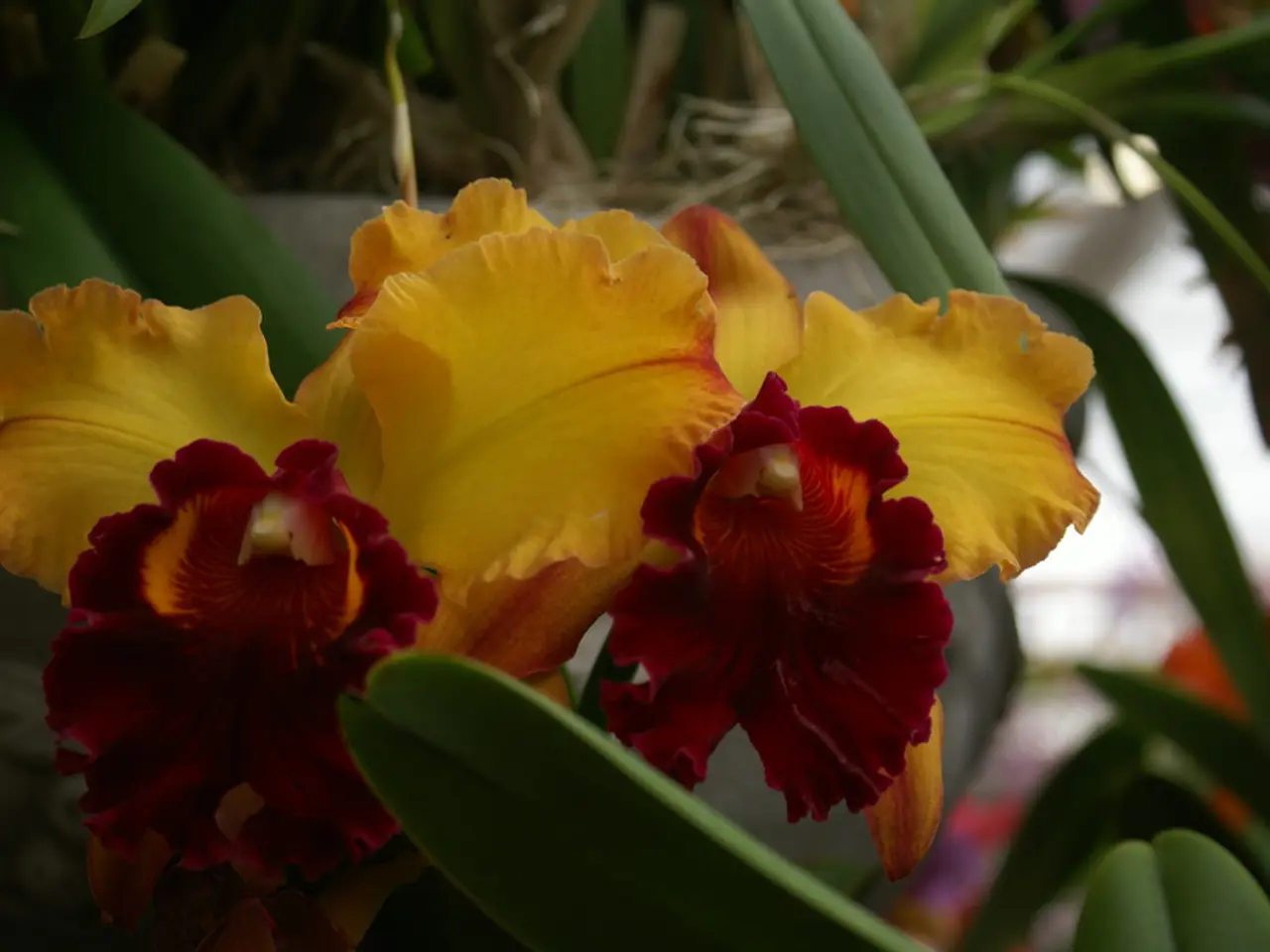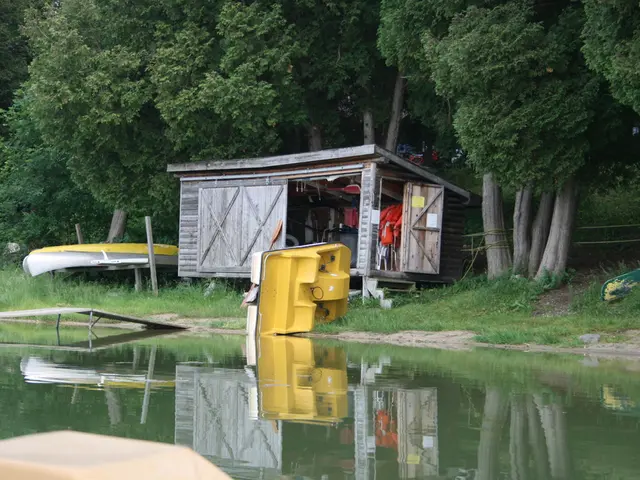Nurturing Delicate Annual Blooms: A Step-by-Step Guide
In Iowa, where USDA Hardiness Zones 4-5 prevail, overwintering tender plants like canna, caladium, elephant's ear, dahlia, gladiolus, calla lily, banana, and tuberous begonia requires careful preparation and storage. Here's a step-by-step guide on how to ensure these plants thrive again in spring.
**Digging and Preparing for Storage**
Once the first frost blackens the foliage, carefully dig up the tubers or rhizomes. Shake off excess soil and rinse gently if necessary. Allow them to dry in a warm, airy place for a few days to cure and reduce the risk of rot. Remove any dead or diseased parts.
**Storage Conditions**
Store tubers in breathable containers (like paper bags or boxes filled with peat moss, vermiculite, or sawdust) to maintain moderate humidity without encouraging mold. Keep the storage area at a cool temperature around 40-50°F (4-10°C), away from freezing and excessive moisture. Check periodically during winter to discard any rotting tubers.
**Soil and Planting in Spring**
Plant after the danger of frost has passed and soil has warmed to about 60°F (16°C). Use well-draining, fertile soil amended with compost. Space plants adequately to accommodate mature size, as tubers like canna and elephant’s ear spread. For caladiums and tuberous begonias, partial shade is preferred, whereas canna, banana, and gladiolus thrive in full sun.
**Watering and Fertilization**
Water moderately during the growing season; avoid waterlogging. Fertilize with a balanced, slow-release fertilizer or monthly liquid feed during active growth. Reduce watering and feeding as the foliage dies back in late summer or fall.
**Additional Tips for Specific Plants**
- *Cannas*: Can be left in the ground with thick mulch but in Iowa’s cold, digging is safer. Divide rhizomes every 3-4 years. - *Elephant’s Ear (Colocasia)*: Must be dug up to avoid frost damage. Store dry and replant in spring. - *Dahlias*: Dig up tubers after frost and store; avoid letting tubers sit in water. - *Gladiolus*: Lift corms after foliage dies; cure and store in a dry, cool place. - *Calla Lily*: In colder climates, dig up and store rhizomes; they prefer moist soil in the growing season. - *Banana*: Tropical banana plants will not survive Iowa winters outdoors; bring potted bananas indoors or treat as annuals. - *Tuberous Begonia*: Dig up tubers before frost, dry, and store similarly to dahlias.
Following these steps will help ensure these tender plants survive Iowa winters and thrive again in spring. Keep in mind that exact timing depends on local frost dates and weather conditions. Regular monitoring during storage is key to prevent rot and ensure healthy regrowth.
For further information, Banana (Musa spp.) & Abyssinian Banana (Ensete spp.) can be overwintered as a houseplant allowed to stay green and grow all winter, or stored as dormant plants and potted up 4 to 6 weeks before the average last frost date. Water tender perennials regularly throughout the summer, and plant them directly in the garden after they have been acclimated to outdoor growing conditions. Prune off dry or yellow lower leaves as close to the ground or stem as possible.
Caladiums can be grown in beds, borders, and containers and perform best in moist, well-drained soils in partial shade. Elephant ears are normally grown from large, round to oval, brown tubers or from rooted plants. Tender perennials are not winter hardy in Iowa and must be dug up in the fall and stored indoors over winter. Caladiums have a moderate fertility requirement and should be fertilized with an all-purpose garden fertilizer or a soluble fertilizer every 2 to 4 weeks. Elephant ears require regular fertilization with a high-nitrogen fertilizer.
Most tender perennials are not drought tolerant, so consistent watering is essential. Tender perennials can be started indoors in late winter for longer enjoyment. Canna rhizomes can be planted outdoors in mid-May in central Iowa (about one week earlier in southern Iowa and one week later in northern Iowa). Caladiums in containers should be checked regularly and watered when the potting soil begins to dry out. Tuberous Begonia (Begonia xtuberhydrida) tubers should be planted indoors about eight weeks before the average last spring frost, and tuberous begonias perform best in moist, well-drained soils in partial shade.
Caladium tubers should be planted 1 to 2 inches deep and placed with the knobby side up. Elephant ears are normally grown from large, round to oval, brown tubers or from rooted plants. Canna rhizomes should be planted in large pots and covered with 3 to 4 inches of potting soil. Gladioli require well-drained soils and perform best in a sunny location. Use water-soluble fertilizers or slow-release granular fertilizers for regular fertilization.
Elephant's Ear (Colocasia, Alocasia, and Xanthosoma) can be started indoors 6 to 8 weeks before the average last frost date. When foliage appears, move the plants to a sunny location or under fluorescent lights. Tender perennials' structures (tubers, rhizomes, etc.) are usually planted directly outdoors in spring. Gladiolus (Gladiolus spp.) corms can be started indoors 4 to 6 weeks before the area's average last frost date to get blooms earlier in the season.
Most benefit from fertilizers that can provide a lot of nitrogen. Remove spent flowers as they appear. Before planting outdoors, harden or acclimate the tender perennials to outdoor growing conditions. Elephant's Ear tubers should be planted 1 to 2 inches deep and 2-4 inches deep in fertile soils once the danger of frost has passed. Regular fertilization is important for getting the most out of tender perennials. Elephant ears prefer part shade and often tolerate full sun (especially with adequate moisture).
Gladioli should be planted after the danger of frost is past, about mid-May in central Iowa. Plant those tender perennials started indoors in the garden after they have been hardened.
- In Iowa's home-and-garden landscape, gardening tender plants like canna, caladium, elephant's ear, dahlia, gladiolus, calla lily, banana, and tuberous begonia requires careful preparations for winter storage.
- For a thriving lawn and garden lifestyle, it's essential to follow extension service recommendations for digging, storing, and planting these tender plants in spring.
- Weeds can pose a threat to the healthy growth of plants; ensure to remove them regularly to prevent competition for resources.
- When the landscape of your home and garden includes tender perennials, be mindful of their specific watering, fertilization, and pruning needs to optimize their growth.
- Consider adding more flowers like caladiums and tuberous begonias to your garden, as they typically perform best in partial shade.
- This lifestyle, which involves caring for and enjoying tender plants throughout the growing season, contributes to the overall beauty and well-being of your home-and-garden landscape.




